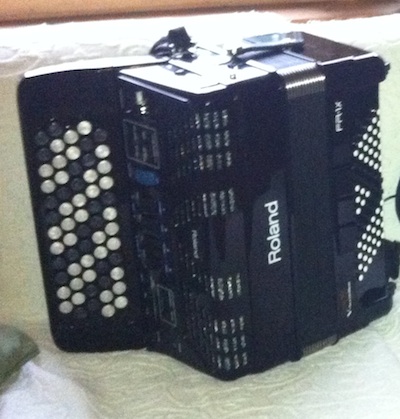Improving the Roland Fr-1xb V-accordion
![]()
A ROLAND BY ACCIDENT
The last three winters in Finland have been cold with a lot of snow in the Helsinki area. Streets have been slippery especially after the snowplows have passed by, they polish the icy streets. A lot of people fall in the streets although they try to be careful when they walk. This happened to me, too. A sore shoulder was the result with injured muscles.Since I am an enthusiastic accordion player the accident was a hard hit to my playing ability. Pulling and pushing the bellows was a pain. I then realized that the Roland Company was offering a new Fr-1xb V-accordion, which was of light weight and reasonably affordable to buy. The best of all, it could be played without moving the bellows. So I went to the Roland shop and came back as an owner of a brand new Roland Fr-1xb.
THE ROLAND EXPERIENCE
I now have owned the Fr-1xb for about half a year and basically I am satisfied with the product. It has saved my music life. I play in several folk music groups and since the instrument is only of 6,5 kg weight it is a delight to carry to playing happenings. I am no more envious of violin, clarinet or mandolin players of their instrument weight.But it looks like even a good product may have certain shortcomings and flaws which the factory could easily rectify if they want to make an excellent product. The following is my list of necessary improvements for the Fr-1xb V-accordion some of which I have already implemented myself.
1. THE ANNOYING BATTERY RECHARGING SYSTEM
Originally the FR-1xb battery recharging required removing all the 8 pcs of the AA-size batteries to be recharged outside of the instrument in a separate charger (not supplied with the accordion). Alternatively the accordion could be played when connected to a wall socket with a cable which was supplied with the instrument. But this cable did not recharge the batteries.I understand the factory's reasons for this system. Besides making the product cheaper it also eliminates the possibility that the user inserts the wrong type of batteries into the instrument which then could damage the instrument if a wrong type of recharging device is connected.
However, for me this recharging system was too laborious and annoying to use and therefore I decided to design my own version. By searching the net I soon found a good recharger for Ni-Mh-type batteries, the Ansmann ACS 110 charger. This unit has many advanced features:
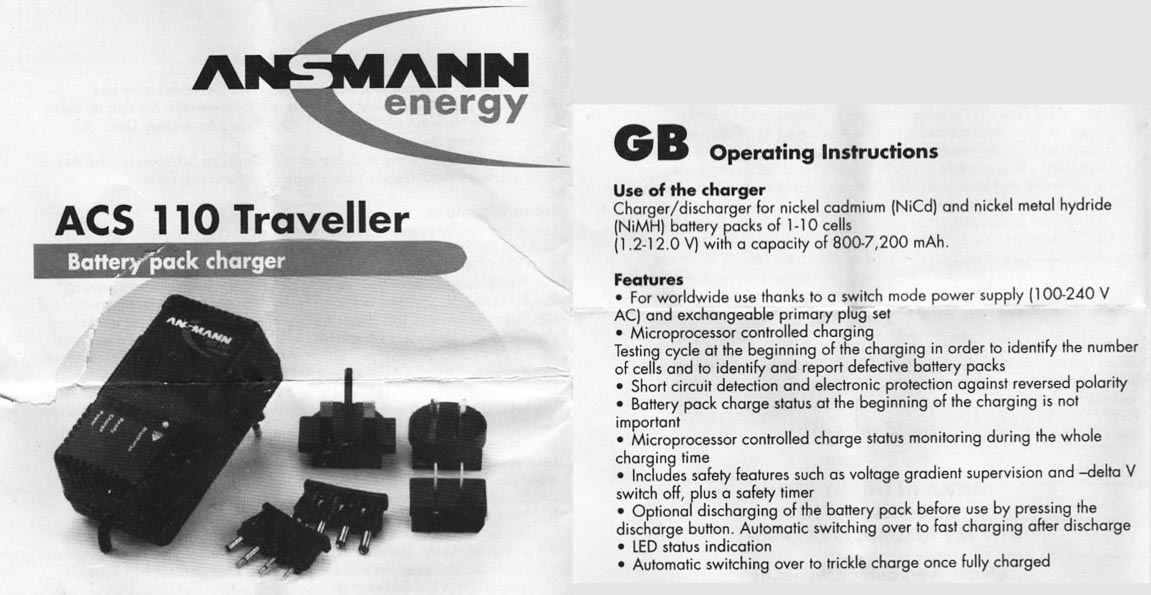
Next I installed a suitable connector to the Accordion battery compartment cover and soldered the wires to the battery pack ends. I have used this system now for some months after the installation and so far the resulting recharging system has proved to be excellent. I have not needed the factory supplied cable any more. For safety reasons I recharge the batteries always Power Off. The charged batteries seem to have a duration of up to 4...5 hours of playing which is well adequate for my needs.
I have no idea yet of what the battery life will be. I have recharged the batteries twice or 3 times a week which may be too often since the battery life depends on the number of recharge cycles.
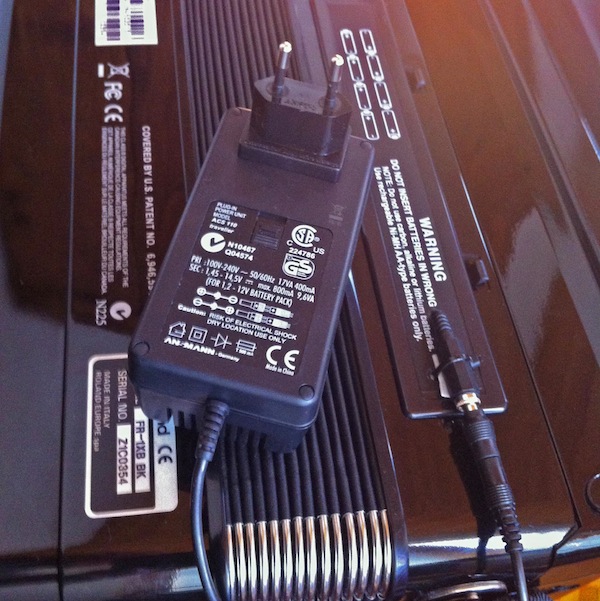
WARNING!
The famous Murphy's law predicts that "anything that can go wrong will go wrong." Therefore, I do not recommend anyone to follow me and copy my recharger installation. Most people do not read the instructions, do not understand the electronics needed for different battery types or they do not care. This may be a prelude to a disaster. Both the Fr-1xb Owner's Manual and the Ansmann ACS 110 recharger Operating Instructions prompt to use Ni-Mh batteries. Li-Ion batteries should not be used, they may damage the accordion if recharged inside the instrument with an unsuitable charger.2. THE HEAVY BELLOWS FORCES
The Roland V-accordions have a bellows system which tries to mimic the acoustic accordion sound generation by having pressure sensors inside the bellows. The electronics are programmed to produce sound with certain pressure readings (plus or minus) which is selectable by the BLC parameter. For my sore shoulder I use the BLC value 3 (Fixed high), which allows the Fr-1xb to be played without using the bellows pressure at all. This saved my accordion playing life.The not so good point of playing with parameter value 3 is the monotonic nuance of sounds, especially with accordion, clarinet and similar sounds. Therefore, I have also tried to use the other BLC parameter values.
However, all the other BLC parameter values are unsuitable for me. No 4 is called Extra Light but still is much heavier to use than my normal accordion? Since this parameter is programmable there should be a couple of lower values offering a one half and one third of the present no 4 parameter value bellows forces.
I have been told that Roland has consulted world champion players concerning the various features of the Fr-1x including the sound response of the bellows pressure. To me this appears to be the completely wrong customer group to consult. World champions do not play the Fr-1x, they play the Fr-7x. Roland should produce some Fr-1x prototypes with much reduced bellows pressure requirement (two more BLC settings, with a half or one third of the present minimum force required) and then consult 10-15 year old girl players, seniors over 60 years, disabled persons like me and ordinary people having less muscle power than world champions.
Since I cannot reprogram my Roland I decided to tinker some electronic and mechanical solutions to the problem. One of my ideas was to make a foot pedal to vary the pressure inside the bellows. Another was a linear potentiometer to be moved with the bellows movement. I made some prototype installations but finally ended up with a mechanical pushrod type device which I can move while playing. After careful measurements of the Fr-1xb dimensions I designed the system using a 3D modeling software and produced the parts of ABS plastics with a 3D printer. My system is not a substitute to the bellows pressure sensors but anyway allows me to adjust sound volume while playing.
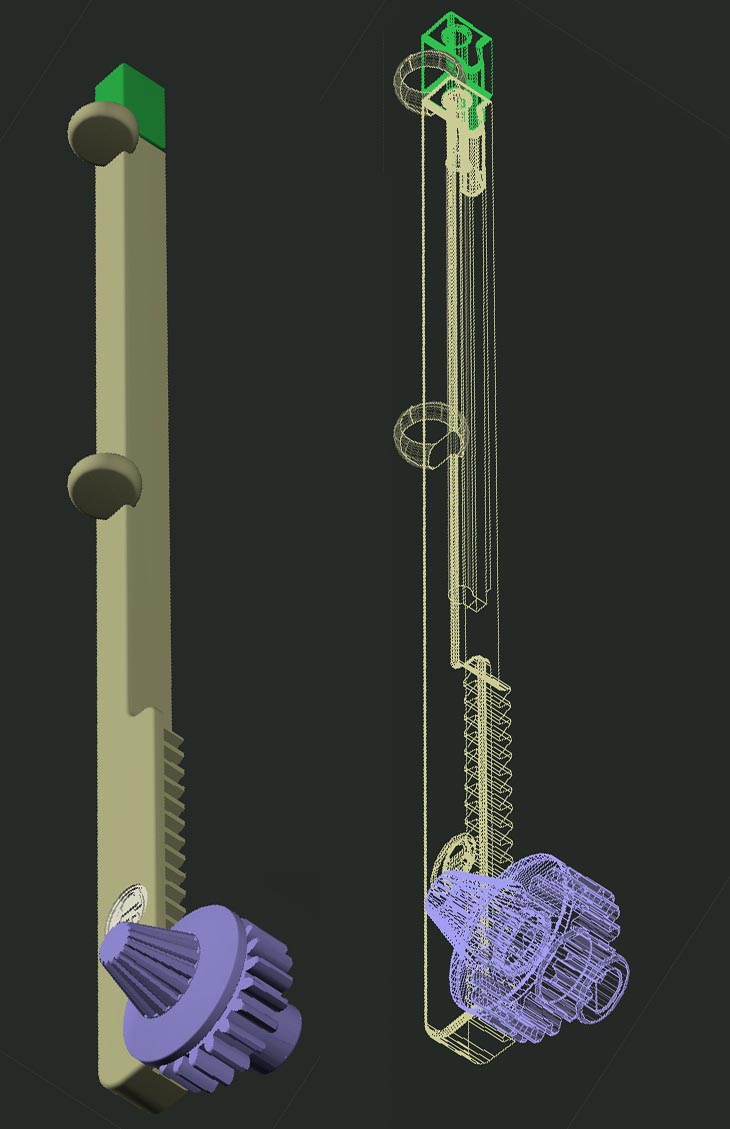
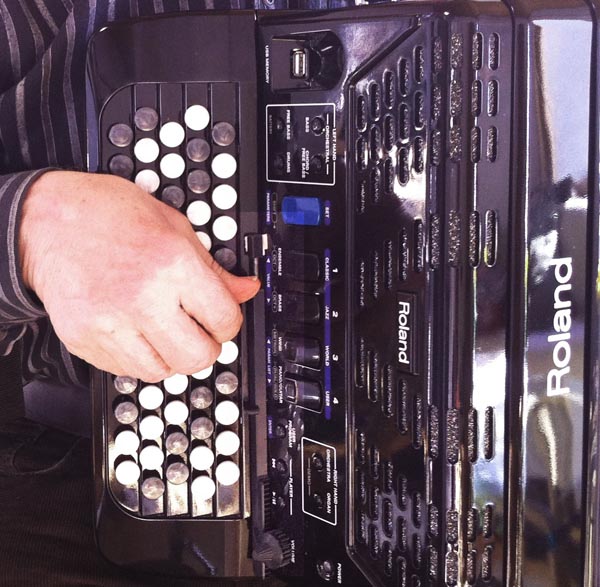
3. THE MASTER TUNING PARAMETER, tun, WHICH CANNOT BE SAVED?
By default the Fr-1x master tuning parameter value (tun) has been set to
A =
440 Hz . The user
can adjust this setting but the bad point is that the user cannot save
the desired value into his own settings file. So, every time the
Fr-1xb is switched OFF and ON
again the user must retune the instrument. This may happen several
times during a playing event due to coffee breaks and other
reasons. The Fr-1x also has an Auto Off function which switches the
instrument OFF after a certain time if not in use. And again you have to
tune the instrument to your desired value. This is a very annoying detail in the Fr-1xb user interface. In Finnish folk music the tuning is always A = 442 Hz which I would like to save into my personal settings. The Roland Company should put their programmers to work to rectify this fault as soon as possible and allow the users of the Fr-1x to save their preferred tuning value into their personal settings file.
4. RESONANCE VIBRATIONS OF THE FR-1x CASING
Loudspeaker boxes are usually made of sturdy and heavy material to avoid any resonance vibrations. This is not possible with the Fr-1xb as it should be a lightweight instrument. If you listen to your playing using headphones or by connecting the Fr-1xb to a separate amplifier and loudspeakers there are no problems.However, I am playing most of the time using the built in speakers and often at full volume. Certain sounds like one clarinet sound tend to resonate at or near the E sound. A heavier loudspeaker box is out of the question as are any kind of stiffeners to the box which would only raise the resonance point to an even more annoying frequency.
The only possibility I see is to make the loudspeaker box or frame softer in structure to lower the resonance frequency so that it falls below the normal playing sounds. I have not opened the Fr-1xb box to see if this would be possible but in my 40 years of design career I have successfully used this method a couple of times to get rid of bad resonances.
I used the Vibration program in my iPhone to see if there is any difference in amplitude of sounds near the E-key and how the E behaves if pressed continuously. The sound is Clarinet.
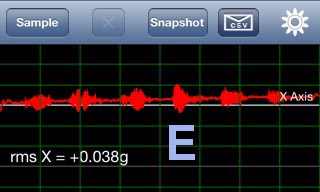
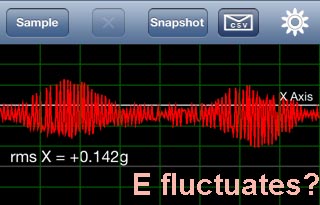
MY MESSAGE TO ROLAND COMPANY:
The Roland Fr-1xb is an excellent instrument and it became even better after I succesfully solved the annoying recharge problem. If we forget the resonance issue, the two remaining problems would require minor recoding of the Fr-1xb system software which only the factory can do. Therefore, I have a proposal to the Roland Company:
Please, make a special version of the system
software and distribute it via internet for those who need it. It
is not necessary to distribute it to all owners of the Fr-1xb.
This system software should have two modifications:
2) A couple of new BLC parameter values offering much smaller forces to pull and push bellows for full sound volume.
3) A master tuning parameter tun-value which can be saved into the users settings file after adjustment.
MUSIC SAMPLES
A polka from Houtskari Island in Finland A medley of Finnish polka music and international dancing samples
By comparison this tango was played with an acoustic accordion and an acoustic violin plus a number of MIDI-instrument tracks payed with my Ketron Midjay module.
COMMENTS TO: 
1. Incredible! Roland should hire you! The amount of effort it
takes to move the Bellows on the Fr1X is bizarre... And I hope Roland
takes your advice and
provides...
soundhoundvt
2. Hello. Enjoyed your video Polka from Houtskari Island and your ingenious volume control.
ja_self
